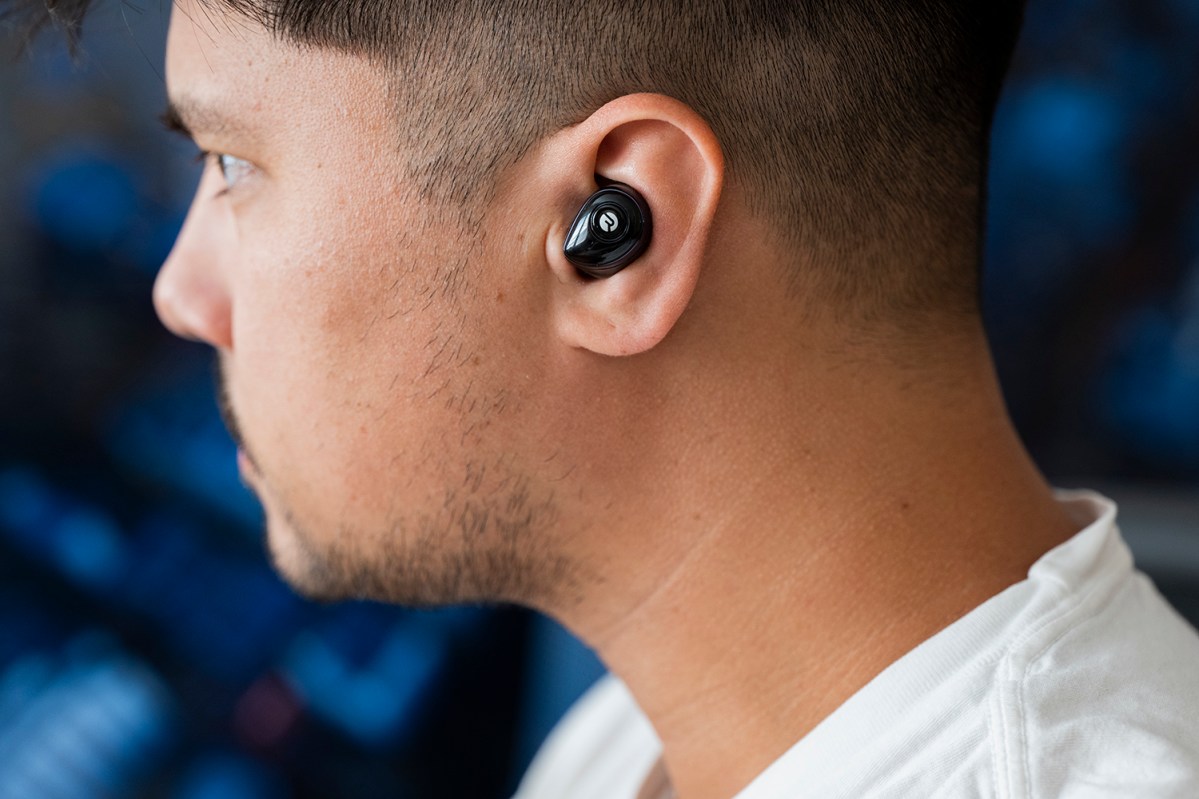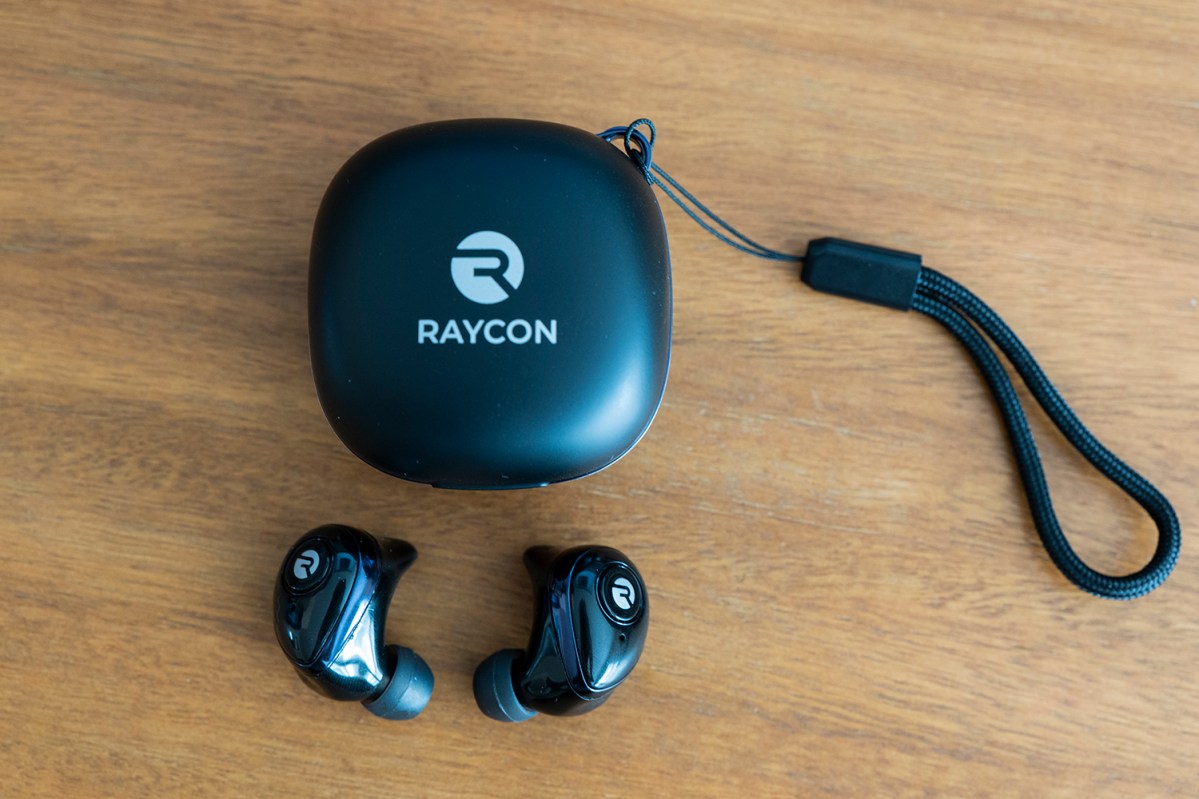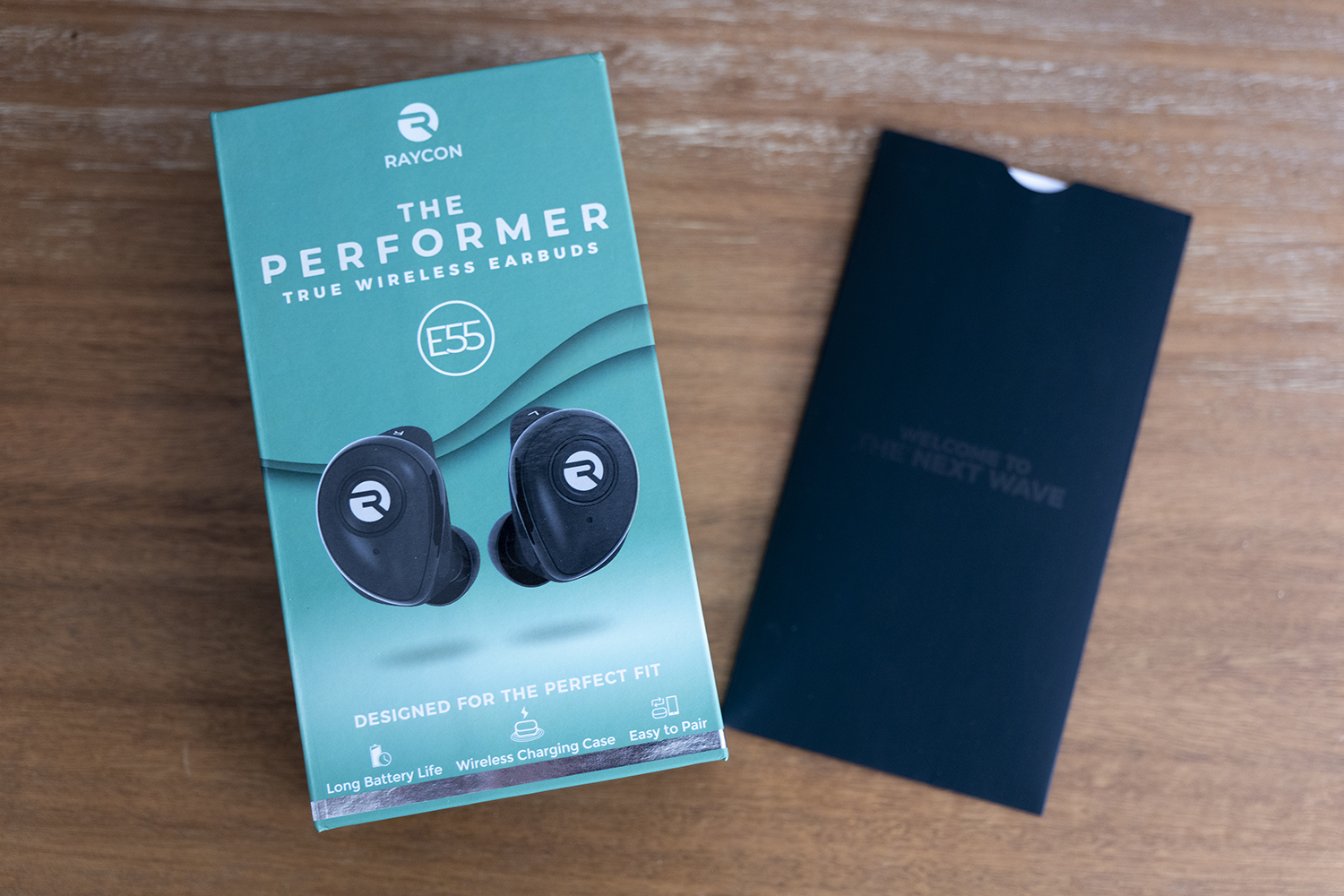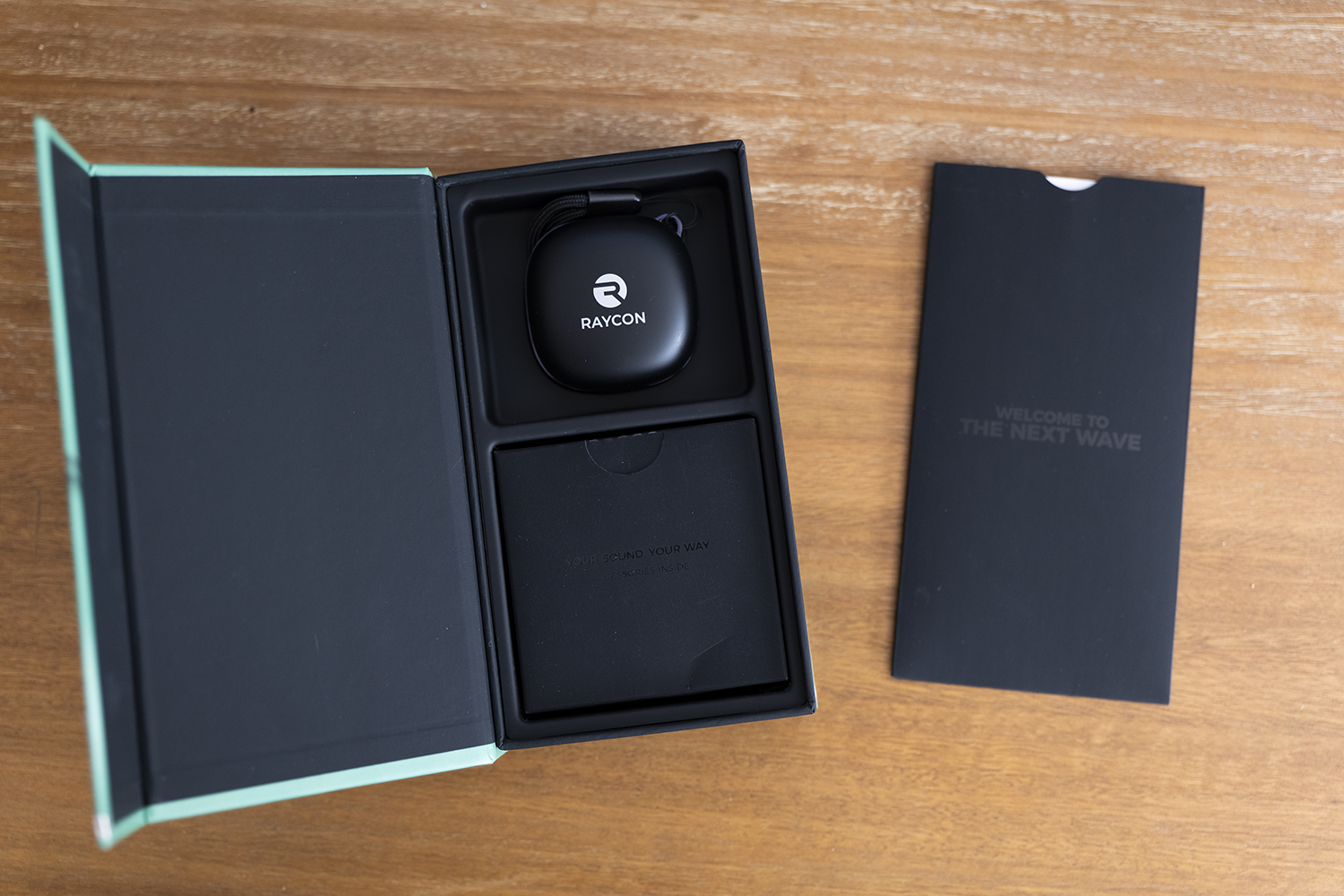
“Raycon’s marketing-heavy hype-machine mostly fails to meet expectations.”
- Comfortable fit
- Small charging case
- Wireless charging
- Cheap-feeling build
- Bass overwhelms mids and highs
- No app, so EQ can’t be adjusted
- Terrible call quality
If you’re like me, you heard of Raycon earbuds while either listening to a sponsored bit on the radio or from your favorite YouTuber. Raycon clearly spends a lot of money on marketing its products, and if you visit the company’s website you’ll see a lot of images of happy customers and some very big names in music supporting the brand.
Clearly a marketing-heavy hype machine, we found ourselves wondering: Are Raycons actually good? We grabbed a pair of the company’s $120 top-of-the-line model called the E55 The Performer earbuds and put them through the paces.
Out of the box
Since Raycon spends so much of its efforts on marketing, it should come as no surprise that the box is pretty darn great. Even the shipping box is Raycon branded, and the actual product box inside offers exactly what I would expect from a higher-end earbud brand.
The front is held down by a magnet and flips open to reveal a jet-black interior and a few pamphlets welcoming you to “the next wave,” which is Raycon’s slogan. The buds are nestled gently in the case below that, with a charging cable and extra eartips in a small square box next to it.
Speaking of eartips, Raycon includes five total silicon eartip sizes, which is more than most companies offer. I personally have very small ear canals, so I swapped out the tips that come attached to the buds for their smallest size.
Fit and finish
The Raycon charging case is delightfully small and light, making even the petite Jabra 75t case look big by comparison. It even looks slightly smaller than the AirPods Pro case, though Raycon went with a more rounded square design over Apple’s rounded rectangle. The case itself has Raycon’s branding emblazoned over the front, with the only mar on the otherwise smooth case being a little plastic loop that lets you run an included mini lanyard through.

I don’t understand the need for a lanyard, and therefore am not a big fan of it. I wish that little loop nub didn’t exist, as it would have made for a much smoother final product. I guess the idea is you might want to attach this to a bag or something, but I honestly don’t trust that the case would stay closed and the buds affixed to the interior if I were to sling these off a zipper on the outside of my backpack. The magnet that keeps the lid closed and the ones that hold the buds in their charging cradle are all quite strong, but I still wouldn’t trust them swinging around behind me.
While we’re on the topic of the magnets, the buds do click nicely and firmly into place while charging, and the case stays snugly closed. No complaints there.
The Raycon earbuds do fit really well in my ear.
The case is compatible with wireless chargers but also can charge via a USB Type-C plug. While charging, a little LED next to the port will glow red. When done, it glows green.
The buds themselves are what I would classify as “cheap” when it comes to their build quality. They’re fully plastic and extremely lightweight, which is actually nice when you consider they have to stay fitted to your ear, but they just don’t feel great to touch. They’re glossy, slippery, and have this low-quality feel to them that’s common with cheap products. So the fact that we got this far with an otherwise high-quality experience only to find the buds to be below that mark is disappointing.
Disappointing quality aside, the Raycon earbuds do fit really well in my ear. They kind of “lock” in place using light pressure from my ear canal and upper concha, which holds them really nicely without causing me any fatigue over time. They actually fit and hold in place better than the AirPods, which surprised me. I also appreciate how flat they lay against my head. It’s probably why Raycon shows so many customer selfies on its website: When worn, they do look good.

The Performer earbuds pair quickly with your phone via the traditional method (using the Bluetooth menu) and will always greet you with a voice that sings “Raycon” every time you turn them on. They pair quickly and reliably, but I have found that they sometimes don’t disconnect when putting them back in their case. More than a handful of times I would put them away and go into another room only to find my iPhone was still connected and trying to send sound to them. This is a problem I’ve only found on really cheap, low-quality earbuds in the past, so it’s not great to see that happen here.
The buds have physical buttons on both the left and right, and they largely work pretty well. There is a slight delay when asking them to do anything, which isn’t out of the ordinary but worth noting. You can pause, play, skip, answer and hang up the phone, and even control volume through a series of different Morse code-esque taps, and they worked as advertised.
Sound and call quality
I’ll cut to the chase here: The Raycon earbuds sound fine. Just, fine. They aren’t going to blow you away with their quality, but if you bought them on a recommendation from your favorite YouTuber, you probably won’t be hugely disappointed either. They do the job, offering heavier than standard bass but not nearly class-leading in that regard. When I initially put them in, I admit I was at first enamored by how much skull-pounding bass they were capable of throwing out, but eventually tired of it because that bass overwhelms the mids and the highs to the point they crush the details. Overall, I think the EQ is off for those who want to hear everything in their music, but they should suffice if you just want to enjoy the beat from your favorite song.

In Sia’s Save My Life, you get a nice feel for the lower frequencies that are akin to a dance club, but the higher timbres that make Sia’s voice so thrilling are lost as the bass muddies so much of the frequency range. If you’re a fan of clear vocals, you probably won’t be overly happy with how the Raycon earbuds sound.
The Raycon earbuds sound fine. Just, fine.
The thing is, if the idea of bass-heavy buds sounds right up your alley, these still aren’t the best choice for that in their price range. The bass is actually stronger in the Jabra Elite 65ts (and the Elite 75ts are even better), and those also let you adjust EQ via an app so you can tailor the listening experience to your specifications. That leads to another downside of the Raycon earbuds: They do not have an app, so what you hear is what you get.
The Raycons don’t offer any kind of noise cancellation, which is pretty normal for earbuds in this price range. That said, the noise isolation you get with these feels sub-par. It might be the flimsy build quality, but without music playing, I can quite easily hear everything going on around me despite them being firmly plugged into my ears.
These are downright terrible for making calls.
Raycon touts its buds as great for phone calls, but the company really shouldn’t: These are downright terrible for making calls. You can hear the other end perfectly fine, but they will struggle to make out your voice as the earbuds make you sound like a mix of being underwater and varying degrees of far away. Your voice will dip in and out to whomever you’re speaking, which makes for an overall terrible listening experience for them.
Battery life and connectivity
Raycon says its buds should last six hours per charge and up to 36 total with the six recharges available in the case. Six hours per charge is really middle of the road to low when compared to what’s out there, but I actually found that the buds outperformed that spec. I wore these for a full workday, eight hours, and they continued to plug along without problems. I think you should probably expect six hours, but if you grab a pair they might actually last longer than that, which is nice. They charge quickly, too, and I honestly didn’t have a big issue here with the battery.

Connectivity wasn’t stellar, and they underperformed against any other modern earbud I have tested. I wasn’t even able to make it halfway into my backyard with my phone in my kitchen, and the buds would start cutting out. If you keep your phone right next to you at all times, you’re probably going to be ok, but I don’t have high hopes these will do well in spaces with a lot of interference, like airports or New York City streets.
Our take
Raycon’s marketing-heavy hype-machine overpromises here, with buds that do enough right that anyone who buys them is likely to be satisfied but come up short of actually being a good recommendation in their price range. In the included literature with the buds, the company claims that its goal from the beginning was to offer high-quality buds at a lower cost than the competition, but they don’t really do that. These buds lack in the features department for $120, but even if you use that YouTube discount code you heard to get them down to $100, they still underperform overall.
Is there a better alternative?
The Jabra Elite 65ts are a great alternative, and even though their MSRP is $120, like the Raycons after that influencer discount code, they are available for typically under $100 now from Amazon. The Edifier TWS6s are also a solid buy, as are the Sony WF-XB700s.
How long will they last?
Raycon offers a one-year warranty, which is pretty standard. The build quality is concerning on these though, so I don’t feel comfortable saying they’ll consistently last much longer than two to three years.
Should you buy them?
No, unless the sole purpose is to support a content creator you like and get something in return. These buds are mediocre, with no real standout feature that makes them better in any way than their competition.
Editors' Recommendations
- Best wireless earbuds for 2024: Sony, Bose, Soundcore, and more
- Best noise-canceling earbuds for 2023: from Sony, Soundcore, Jabra, and more
- Sennheiser Momentum True Wireless 2 vs. Apple AirPods Pro: Which should you buy?
- Klipsch T5 True Wireless vs. Apple AirPods: Battle of the buds
- Echo Buds vs. AirPods






